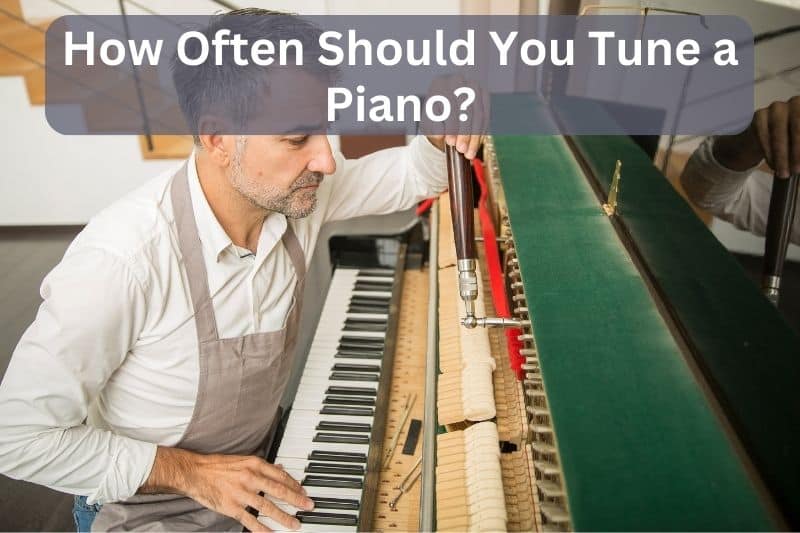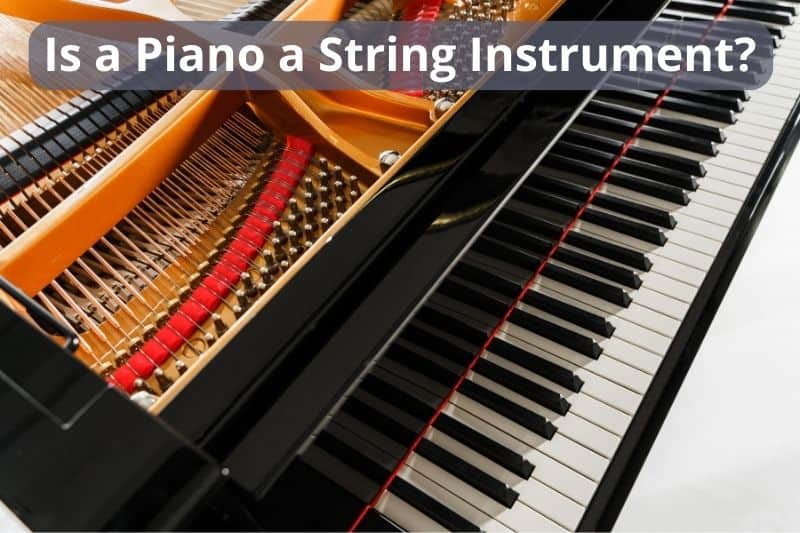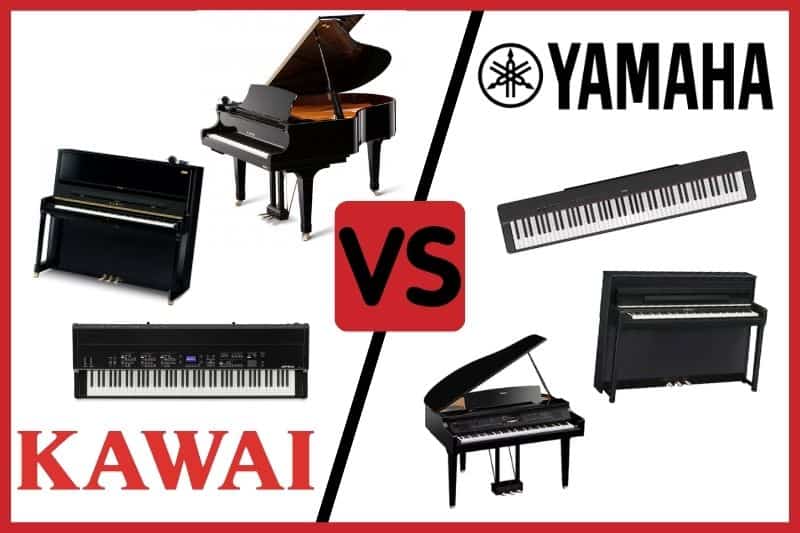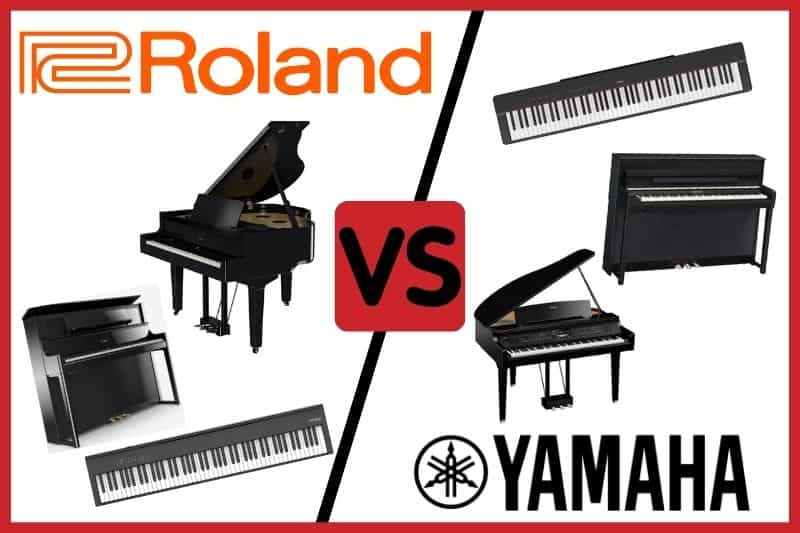If you want to make music with a keyboard, you have a few options. One of those is that you can use a digital piano, which functions much like an acoustic one. Another way is to use a MIDI controller, which you connect to your computer to make music. But you might be wondering which one is best for you.
What’s the difference between a digital piano and a MIDI controller?
A digital piano mimics an acoustic one, except it uses recorded samples and speakers to produce sound, rather than strings. Alternatively, a MIDI controller can look like a piano keyboard, but it will need to be connected to a computer with a Digital Audio Workstation (DAW) to make any sound.
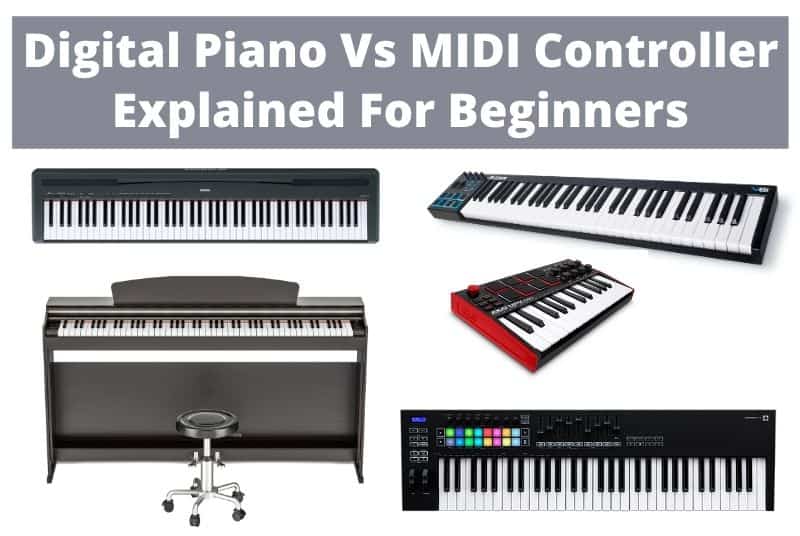
If you want to choose between a digital piano and a MIDI controller, you should know the differences between them, as well as their similarities. What’s more, you can even use a digital piano as a MIDI controller.
What Is a Digital Piano?
A digital piano is very similar to an acoustic one in that it can produce the sounds of a piano without a computer. However, digital pianos use recorded piano sounds to imitate acoustic instruments. Like acoustic pianos, digital ones come in a few configurations and sizes.
Digital pianos can have the standard 88 keys that you’ll find on an acoustic piano. You can also find some digital pianos with fewer keys (61 or 76), which can be useful if you don’t have much space to play or store the keyboard. A digital piano uses speakers to project the sound, which you can adjust the volume level as well as a headphone jack so you can listen to the music you make without disturbing others.
Some digital pianos offer other sounds, such as a harpsichord, electric organ, or other orchestral instruments. With others, you can adjust the settings and play whatever sounds you like. If you have the power cord and an outlet, you’re good to go, and you can start making music.
But there’s more to a digital piano than its basic features and setup. If you’re deciding between a digital piano and a MIDI controller, there are some essential differences.
What It Looks Like
Many digital pianos look similar to their acoustic cousins. They have the same design of white and black keys. Some digital pianos even have a similar casing to an acoustic piano, and that casing is one of the features that help with the sound.
However, you can also find digital pianos that don’t look very much like acoustic instruments. Instead, they just have a keyboard and a control panel with different sound settings. These pianos typically have a speaker on either side of the settings.
Digital pianos that don’t come with a casing might include a keyboard stand so that you can adjust the piano’s height. Pianos like that are more flexible, and you can play them while sitting or standing. They’re also usually more portable than those resembling grand or upright ones.
Still, most digital pianos of any kind have keys that are the standard size. You shouldn’t have to worry about squeezing your fingers together to play.
How Big It Is
Aside from overall looks, a digital piano can be as wide as an acoustic one. However, as mentioned above, you can find digital pianos with fewer keys, limiting the range you can play.
- Digital keyboards are similar in size to MIDI controllers in that they don’t always sit on a stand or case.
- Some are small enough to put them on your desk and use them as a MIDI controller.
- The keyboard itself can be a couple of feet deep and a few inches high.
- If you’re looking at full-sized digital pianos with 88 keys, they’re usually 51 to 57 inches (130-135cm) wide. Keyboards with 76 keys are about 50 inches (127 cm) wide.
Even the biggest digital piano is most likely going to be smaller than an acoustic piano. On the other hand, the smallest digital piano is probably bigger than most MIDI controllers. When deciding between a digital keyboard and a MIDI controller, you should consider how much space you have.
Luckily, you can find digital pianos in a variety of sizes. Even if you have a small living space, you can still make it work.
How It Feels
Another thing to consider when comparing digital pianos and MIDI controllers is how they feel to play. Some digital pianos feel very similar to acoustic ones when you play them. This, in part, can be because of the keys weight options that can replicate those found on traditional acoustic versions where the lower notes’ keys are heavier than those of the higher ones. If you’re serious about playing the piano you will want a keyboard that has this feature.
You can find unweighted keys on some of the cheaper pianos keyboards, as well as MIDI controllers where piano playing is not a major feature. With these, you don’t need to exert as much pressure to play them and they’re not great for developing good piano technique.
The size of individual keys is usually the same on a digital piano as an acoustic one. All the keys are large enough to play them comfortably without having to reach too much. Even if you play a digital piano with unweighted keys, the key size can make a huge difference in how easy an instrument is to play.
While you might find a MIDI controller with full-sized keys, it’s not as common. Part of that is because digital pianos are better for live performance, while MIDI controllers shine in the studio. Still, it’s worth considering how the feel of each differs.
How It Works
One of the most significant differences between digital pianos and MIDI controllers is how each works. Digital pianos and MIDI controller keyboards may look similar. However, the way they produce sound is very different.
- Digital pianos use recorded sounds (samples) and speakers to produce sound.
- When you press a key, the key sends an electronic message to the soundboard to produce that note.
- If you change the instrument sound, the piano will register that change and play the corresponding sound.
- When you connect a sustain pedal and press it while playing a note, the digital piano will know to hold the sound after you stop pressing the key.
- Since digital pianos are digital, you’ll need to plug in the power cord and turn on the power before any of this can happen.
- However, you don’t need any extra accessories or equipment to play it.
Understanding how a digital piano works and produces sound is essential to differentiate it from a MIDI controller. While you can use a digital piano as a MIDI controller, it’s more versatile. You can play a variety of instruments, and you can play it with or without a computer.
What You Need
Before you start to play a digital piano, consider what you need to play it. While you may be able to sit at an acoustic piano and play it right away, digital pianos require some setup. Consider these things so that you can make the most out of it.
- Many digital pianos come with a power cord that you’ll need to connect the keyboard to an outlet. However, you may find some digital pianos that use batteries instead.
- Since digital pianos produce sound through speakers, and you can also use headphones. Headphones will stop the sound from coming out of the speakers, but you can still listen to yourself.
- If you want to play more lyrical or fluid music, you can use a sustain pedal. It will hold the notes even after you stop pressing the keys.
- You might also consider a piano bench or a chair so that you can sit comfortably while playing.
When you start playing a digital piano, you don’t need a ton of stuff. However, you should have an energy source, and you should be comfortable. Depending on how you use your digital piano, you may find that you need other accessories, but you can get those when you need them.
Uses for a Digital Piano
One of the best things about playing a digital piano is that it’s an excellent alternative to an acoustic one. You will have more flexibility when it comes to space to put it, and the sound it makes when you play it. If you have a portable one, you can even take it on the go to different gigs.
You can even use a digital piano as MIDI controller as the below video shows. Most, if not all will have USB or MIDI connections that you can connect to your computer. Once you’ve uploaded a DAW, you’re good to go.
You can play the digital piano on its own or through a computer that you can connect to either through a MIDI or USB cable. Either way, you can experiment with different sounds on your piano. Whether you are or want to become a proficient piano player, a digital piano doesn’t have many limitations.
Another great feature you can do with a digital piano is to connect to one of the various online learning apps. When you connect through your MIDI/USB cable, you can play in time with the lesson or piece of music and get feedback on your progress.
If you have a digital piano with fewer keys, you can upgrade to a full-sized keyboard. Then, you can play any note and replicate the experience found on a real piano.
How Much It Costs
Another big difference between digital pianos and MIDI controllers is how much they cost. Now, you can find both cheap and expensive digital pianos. It depends on the brand and model that you want. Models with more specs, features, and acoustic piano mannerisms will generally cost more.
You can find a few digital pianos under $500 and some over $10,000 with a sweet spot between $750 – $1500, depending of course on what you are looking for. Digital pianos with a full set of 88 keys will also typically cost more than pianos with fewer keys. However, most digital pianos will cost more than comparable MIDI controller keyboards.
After all, you will get a better piano experience with a digital version than MIDI controllers. But that doesn’t mean that a digital piano is better than a MIDI controller. For some people, a controller is the better option.
“The piano keys are black and white, but they sound like a million colors in your mind.” -Maria Christina Mena
What Is a MIDI Controller?
MIDI stands for Musical Instrument Digital Interface, and basically, that’s what it is. A MIDI controller is an electronic instrument that you can use to transmit MIDI data to a music program. If you plug your controller into your computer and load your music software choice, you can record tracks.
MIDI controllers come in all shapes and sizes, and they can do a lot of different things. They can be just as versatile as digital pianos, but there are a few limitations. Unfortunately, MIDI controllers won’t make a sound without being connected to a computer.
You also may not be able to play complicated music as easily on a controller as a piano. The design feel and purpose of a MIDI controller can vary from controller to controller. If you decide to go with a MIDI controller keyboard, make sure you know the options.
MIDI controllers can be an excellent option for recording or working with digital music. Some controllers are similar to digital pianos, but some are very different.
What It Looks Like
MIDI controllers come in a variety of guises. While you might be thinking of a MIDI controller keyboard, you can find controllers that replicate drum pads, string and wind instruments. Of course, MIDI controllers in the form of another instrument are very different from digital pianos.
Considering only MIDI controller keyboards, you may still encounter quite a few differences. Many MIDI controller keyboards are smaller than digital pianos, and they rarely come with any sort of stand or case.
MIDI controller keyboards do look like small, compact versions of pianos though. They have the same white and black keys, are in the same order, and you can find controllers with key ranges from 25 up to 88. However, the latter key number controllers aren’t as popular as 88-key pianos.
Still, you can play a MIDI controller keyboard like you would a digital piano. You may have to consider the size and number of keys, but it’s a useful tool.
How Big It Is
Just like the size of digital pianos can vary, so can the size of MIDI controller keyboards. Of course, the most significant factor that determines the size is the number of keys. However, other settings and buttons can affect the size of the keyboard.
- The smallest controller keyboards have 25 keys and can be just over a foot wide (30cm). On the other hand, controllers with 88 keys are close to six feet wide (180cm).
- A controller with 32 keys measures about 17 inches in width (43cm) and 49-key controllers is 32 inches wide (81cm).
- If you choose a controller with 61 keys, it will measure about 40 inches wide. (101cm)
- Of course, the width of individual keys can also affect the width of the entire keyboard.
- Factors like buttons and sound settings can also make the keyboard longer in terms of depth.
Overall, you won’t have to worry about the size and width of a stand or a piano bench. However, a controller with more keys will still take up more space. Still, MIDI controller keyboards are usually smaller and more portable than their digital piano counterparts.
How It Feels
A MIDI controller keyboard can feel similar to a digital piano, or it can feel very different. Depending on the controller you have, the keys may not have as much weight as a piano. If you’ve played the piano for a while, this can be a shock to your fingers.
You may also find that the keys on your controller are much smaller than on a piano. Because you probably won’t play a full concert on it, the keys don’t have to be as large. However, you will have to be more careful when using your controller to record and produce music.
The smaller keys may require more precision, so you may have to record more than once or record more slowly. If you don’t have the patience to do that, you should look for a controller with bigger keys. Or you can use a digital piano as a substitute for a MIDI controller.
If you’re new to working with a piano, a MIDI controller keyboard can be a great option. You won’t have to worry about building up the finger strength to play it, and you’ll have an excuse to take it slow. But you should know how it works before you invest in one.
How It Works
While the size and feel of a controller keyboard are different from a piano, so are the way each instrument works. For most people, it’s easy to understand how a digital piano works. You sit at the piano, turn it on, press the keys, and the speakers produce the sound. But a MIDI controller doesn’t work that way.
- First, you must connect your MIDI controller to your computer.
- You’ll also need to load up a program or piece of software that uses MIDI input. Options include DAWs and music notation programs.
- Next, you need to create a project and a track for your MIDI input.
- Once you have that setup, you can press the keys on your MIDI controller keyboard. However, you may not hear anything.
- The controller will produce MIDI data that the software analyzes. As you play your recording, you will hear the music that you played on your controller.
MIDI can be hard to understand, especially if you’ve never worked with it before. You may need to practice with it to figure out how it works. However, once you grasp it, you can do a lot with MIDI input and output.
What You Need
For better or worse, you need a few extra devices and accessories to use a MIDI controller. Of course, you need the controller itself, but that’s only the beginning. Since MIDI controllers don’t produce sound, so you’ll need a device to create the sound.
The most popular option for creating sound with a MIDI controller is a computer. You can use Mac or Windows, whatever you already use. Some tablets, like iPads, even work well if you don’t have a computer.
Next, you’ll need some sort of MIDI-compatible software. If you want to record music, you can use a Digital Audio Workstation (DAW), like FL Studio. Or if you’re going to compose music to play on a digital piano or another instrument, you can use a notation program, like Finale.
Of course, you’ll also need a cable to connect your controller to your computer. Your computer should have speakers, or you should have headphones so that you can listen to your music after you input the MIDI data.
Uses for a MIDI Controller
A big difference between digital pianos and MIDI controllers is how you can use them. While a MIDI controller keyboard looks a lot like a digital piano, you can use them for very different purposes.
- The most common way to use a MIDI controller is to compose or record directly into your computer.
- You don’t need to worry about disturbing others or wearing headphones while you record. That means you can record at any time of the day.
- However, the controller keyboard will pick up on your finger pressure so that it can detect changes in volume. But recording the speakers of a digital piano won’t do that.
- Depending on the program you use, you may have access to different sounds than with a digital piano. You can download plugins with soundbanks, and you can experiment.
- Of course, you can also find MIDI keyboards that resemble digital pianos. The M Audio Hammer 88 (link) being one with hammer action keys for those looking for a realistic acoustic feel too.
Overall, the best use for either a MIDI controller or a digital piano is how you want to use it. You can do a lot with both options, and you can use a digital piano as a controller.
How Much It Costs
The cost of a MIDI controller can depend on a few factors. First, the size and design of the controller are important. If you want a controller keyboard, you should consider the number of keys it has and the key size.
You can pay up to $2,000 for an 88 weighted key controller that visibly resembles a piano keyboard to those sub $100 that have 28 – 49 keys. There are many other options in the $100 – $500 range.
If you’re open to other types of MIDI controllers, you can consider those. If you’ve played a string or wind instrument, you can choose a controller with that design. Drummers can select a drum pad and set the buttons to trigger different sounds.
Whatever type of controller you choose, some options will be cheaper than others, especially if there are fewer features and specs. Luckily, you don’t need the controller with the most features. Whether you’re a beginner or a professional, you can get by with a few features, and you can select software with the sounds you want.
Still, even the controller with the most features won’t cost as much as the most expensive digital piano. After all, controllers have some limits that you need to consider when using them. But they can still be a fantastic piece of gear for you to have.
Digital Piano vs. MIDI Controller
Digital pianos and MIDI controllers share some features, but they are different instruments in many ways. A digital piano can function much like an acoustic one, but you’ll need a computer to operate a MIDI controller.
You should consider what features you need or want in a digital instrument. Then, you can decide if the differences are enough to make you choose one over the other.
| Digital Pianos | MIDI Controllers |
| Some look similar and have the same shape as acoustic pianos | Most are small and have fewer keys and/or smaller keys |
| Can be as wide as an acoustic piano but usually shorter, sometimes portable | Often portable, even if it has a full keyboard, usually thin |
| Many feel like acoustic pianos, with weighted, full-sized keys | Keys are sometimes unweighted and thinner than regular piano keys |
| Uses power cord, digital system, and speaker to produce a sound | Uses a computer program to input data but doesn’t produce sound |
| Included power cord, maybe a foot pedal | Requires a proper computer and compatible software, also a MIDI cable |
| Works well for live performances, recordings, etc. | Best for recording or composing, not suitable for performing complex parts |
Final Thoughts
Digital pianos and MIDI controller keyboards are both relatively affordable, and they share some features, but their differences outweigh their similarities. If you’re trying to decide between a digital piano and a MIDI controller, you should consider their features and, ultimately, what you want to achieve with it. If you are looking just to play the piano, then go with a digital version of that. But if you’re going to create digital music, then a MIDI might be the way to go. If you still can’t decide after reviewing all your options, then it might be worth going with a digital piano so that you can use it as an instrument and as a controller.
